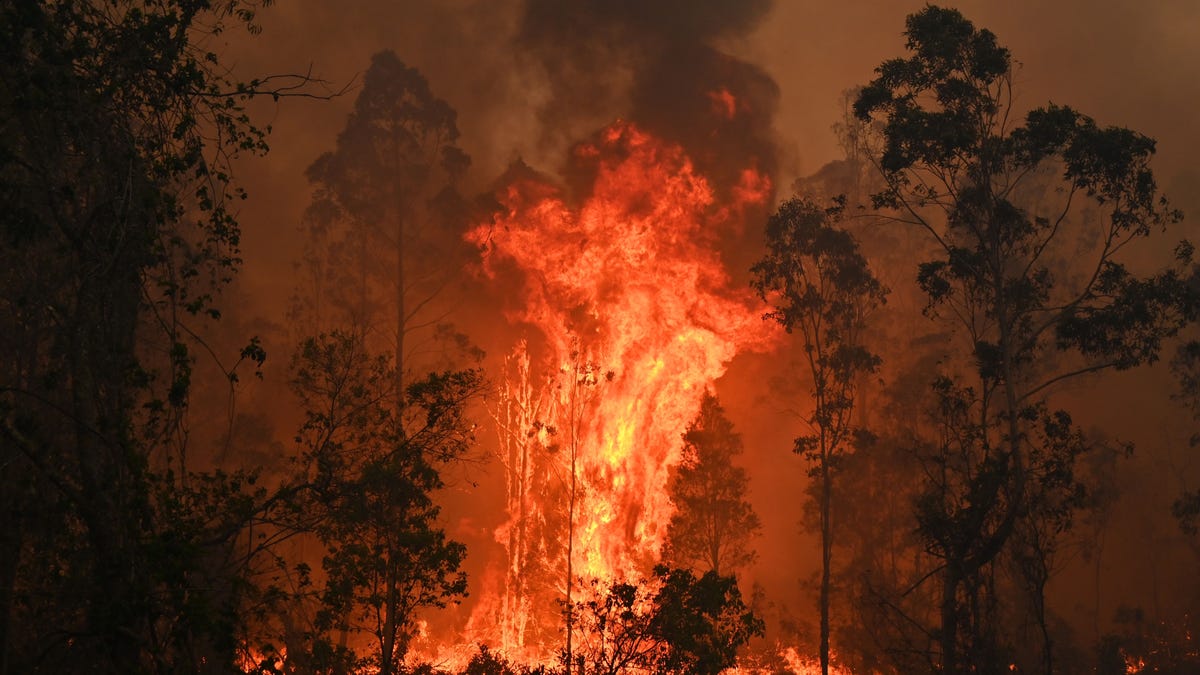Wildfire Smoke Ravaged Earth's Ozone Layer, and It's Going to Get Worse
Without an intact ozone layer, UV radiation could increase people's risks of skin cancer and weakened immune systems.

A fire rages in Bobin, Australia, on November 9, 2019, as firefighters try to contain dozens of blazes raging out of control in the state of New South Wales.
In 2019 and 2020, deadly fires burned through about 46 million acres of Australian land, ripping through towns on the ground while blowing dangerous clouds of smoke into the sky -- a blend that earned the tragic times the ominous label Black Summer.
For months, according to a new study published Thursday in the journal Science based on satellite atmospheric data, the smoky shrouds ravaged Earth's ozone layer in the Southern Hemisphere. The team warns that if major wildfires increase in frequency, we'll see more of this destruction in coming years -- and with the climate crisis, excessive greenhouse gas emissions are fostering just the right conditions for these disasters.
"The Australian fires injected acidic smoke particles into the stratosphere, disrupting the chlorine, hydrogen and nitrogen chemistry that regulate ozone," Peter Bernath, a chemist at the University of Waterloo and lead author of the study, said in a statement.
After analyzing satellite data collected from the Canadian Space Agency's Atmospheric Chemistry Experiment around the time of the Black Summer fires, Bernath and colleagues saw that smoke ascending from the calamity essentially converted compounds that normally support ozone into those that destroy it.
Bernath explains that the team's work offers the first large-scale measurement of Australian bushfire smoke, especially because "models can't reproduce atmospheric smoke chemistry yet, so our measurements provide a unique look at chemistry not seen before."
But this isn't the first time such a conjecture has been made.
A Massachusetts Institute of Technology research group, for instance, also provides evidence for the correlation between Black Summer smoke and ozone depletion. Proof continues to strengthen that wildfires may heavily increase our vulnerability to the dark side of sunshine.
Why we have to worry about the ozone layer
You can think of our planet's ozone layer like a fragile contact lens placed right over the Earth.
Though it seems delicate, this shield protects us from a whopping 95% of ultraviolet radiation, or hazardous rays constantly emanating from the sun. Without ozone, humans run the risk of developing cancer, cataracts and weakened immune systems. Excessive UV radiation can also drastically harm wildlife, marine life and reduce crop yields.
In short, ozone is crucial to our survival, so it's best for it to remain as strong as possible.
This animation shows changes in the ozone hole's size over time.
Thankfully, on that note, the new study's research team says the wildfire-induced ozone damage they discovered was temporary. Once smoke in the region dissipated, it appeared to return to its pre-wildfire state, akin to how the massive ozone hole over Antarctica is very slowly healing itself as the years go by.
But here's the bad news.
Climate change's domino effect on ozone
This sort of temporary ozone destruction, the team says, will increase going forward if major wildfire severity and frequency grows over time.
In this regard, things aren't looking good.
For instance, research published Wednesday reported concrete evidence that the last 20 or so years have seen marked increases in wildfire size and frequency, with projections only trending upward. "The worst fire disasters are still to come," one researcher said in a statement. The vicious Australian bushfires are a firsthand testament to that fact, as are the 2020 and 2021 wildfires that ravaged the US West Coast and this year's huge fires that swept across Colorado.
The AirNow fire and smoke map shows a film of gray wildfire smoke across most of the US on July 20, 2021.
To make matters worse, multiple studies attribute this growing trend to the human-caused climate crisis, which, worryingly, also is ramping up.
The climate connection arises from science that suggests sudden global warming leads to drought and dried organic matter, both of which are precursors to wildfires. According to the newest report from the Intergovernmental Panel On Climate Change, humanity is having trouble keeping up with and adapting to the threats of the crisis.
Experts strongly urge that we must immediately reduce greenhouse gas emissions if we hope to get back on track. These gasses, like carbon dioxide and methane, are among the main contributors to global warming and ozone depletion on their own. But as touched on by the new paper, they also set into motion a domino effect that seems to end in repeated ozone damage. It's yet another reason why we have to step up the battle against climate change.

